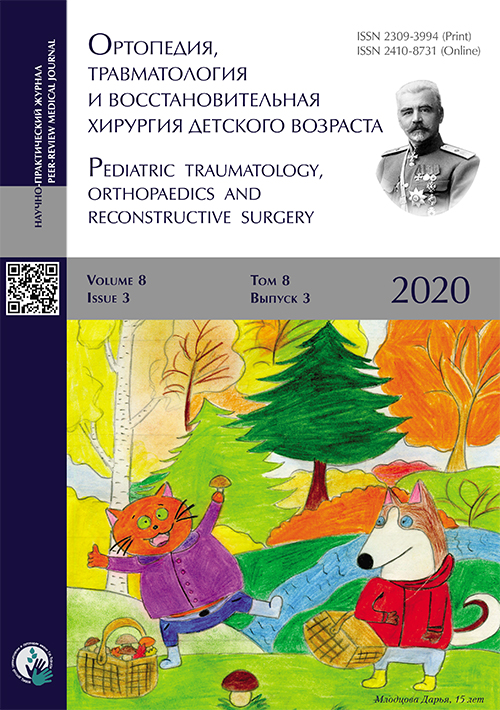Анализ рентгенометрических показателей суставного отростка лопатки у детей с нестабильностью плечевого сустава
- Авторы: Прощенко Я.Н.1, Лукьянов С.А.1
-
Учреждения:
- Федеральное государственное бюджетное учреждение «Национальный медицинский исследовательский центр детской травматологии ортопедии имени Г.И. Турнера» Министерства здравоохранения Российской Федерации
- Выпуск: Том 8, № 3 (2020)
- Страницы: 275-280
- Раздел: Оригинальные исследования
- Статья получена: 24.04.2020
- Статья одобрена: 15.07.2020
- Статья опубликована: 06.10.2020
- URL: https://journals.eco-vector.com/turner/article/view/33878
- DOI: https://doi.org/10.17816/PTORS33878
- ID: 33878
Цитировать
Аннотация
Обоснование. Плечевой сустав занимает первое место среди всех суставов конечностей по частоте развития вывихов. При этом рецидивирующая нестабильность плечевого сустава развивается в подавляющем большинстве случаев у пациентов детского и подросткового возраста и в дальнейшем может приводить к стойкому болевому синдрому. По данным литературы, особенности пространственного положения суставного отростка лопатки можно рассматривать как фактор риска развития нестабильности в плечевом суставе у взрослых пациентов. При этом отсутствуют достоверные данные о влиянии показателей, характеризующих пространственное положение суставного отростка лопатки, на возникновение нестабильности в плечевом суставе у детей и подростков, что и стало предметом нашего исследования.
Цель — уточнить влияние показателей изменения верcии и инклинации суставного отростка лопатки на нестабильность плечевого сустава у пациентов детского возраста.
Материалы и методы. В работе представлен анализ результатов обследования 42 детей с привычным вывихом плеча травматического и произвольным вывихом атравматического генеза. Средний возраст обследованных детей составил 15,57 ± 1,75 и 15,07 ± 1,64 года для групп детей с нестабильностью плечевого сустава травматического и атравматического генеза соответственно.
Результаты. При статистической обработке данных достоверных различий показателей верcии и инклинации суставного отростка лопатки между группами с травматической и атравматической нестабильностью плечевого сустава выявлено не было. Следует также отметить, что средние величины показателей верcии и инклинации находились в диапазоне нормальных значений.
Заключение. В связи с этим можно предположить, что в возрасте 11–17 лет ведущую роль в формировании нестабильности плечевого сустава играют динамические и статические мягкотканные стабилизаторы плечевого сустава.
Ключевые слова
Полный текст
Об авторах
Ярослав Николаевич Прощенко
Федеральное государственное бюджетное учреждение «Национальный медицинский исследовательский центр детской травматологии ортопедии имени Г.И. Турнера» Министерства здравоохранения Российской Федерации
Email: yar-2011@list.ru
ORCID iD: 0000-0002-3328-2070
канд. мед. наук, старший научный сотрудник отделения последствий травм и ревматоидного артрита
Россия, Санкт-ПетербургСергей Андреевич Лукьянов
Федеральное государственное бюджетное учреждение «Национальный медицинский исследовательский центр детской травматологии ортопедии имени Г.И. Турнера» Министерства здравоохранения Российской Федерации
Автор, ответственный за переписку.
Email: Sergey.lukyanov95@yandex.ru
ORCID iD: 0000-0002-8278-7032
клинический ординатор
Россия, Санкт-ПетербургСписок литературы
- Brophy RH, Marx RG. The treatment of traumatic anterior instability of the shoulder: Nonoperative and surgical treatment. Arthroscopy. 2009;25(3):298-304. https://doi.org/10.1016/j.arthro.2008.12.007.
- Robinson CM, Dobson RJ. Anterior instability of the shoulder after trauma. J Bone Joint Surg Br. 2004;86-B(4):469-479. https://doi.org/10.1302/0301-620x.86b4.15014.
- Deitch J, Mehlman CT, Foad SL, et al. Traumatic anterior shoulder dislocation in adolescents. Am J Sports Med. 2003;31(5):758-763. https://doi.org/10.1177/03635465030310052001.
- Inui H, Nobuhara K. Glenoid osteotomy for atraumatic posteroinferior shoulder instability associated with glenoid dysplasia. Bone Joint J. 2018;100-B(3):331-337. https://doi.org/10.1302/0301-620X.100B3.BJJ-2017-1039.R1.
- Olds M, Donaldson K, Ellis R, Kersten P. In children 18 years and under, what promotes recurrent shoulder instability after traumatic anterior shoulder dislocation? A systematic review and meta-analysis of risk factors. Br J Sports Med. 2016;50(18):1135-1141. https://doi.org/10.1136/bjsports-2015-095149.
- Прощенко Я.Н., Дроздецкий А.П., Овсянкин А.В., Бортулев П.И. Вывих в плечевом суставе у детей // Ортопедия, травматология и восстановительная хирургия детского возраста. – 2011. – № 2. – С. 57–62. [Proshchenko YN, Drozdetskiy AP, Ovsyankin AV, Bortulev PI. Vyvikh v plechevom sustave u detey. Pediatric traumatology, orthopaedics and reconstructive surgery. 2011;(2):57-62. (In Russ.)]
- Aygun U, Calik Y, Isik C, et al. The importance of glenoid version in patients with anterior dislocation of the shoulder. J Shoulder Elbow Surg. 2016;25(12):1930-1936. https://doi.org/10.1016/j.jse.2016.09.018.
- Прощенко Я.Н., Баиндурашвили А.Г., Брянская А.И., и др. Формы нестабильности плечевого сустава у детей // Ортопедия, травматология и восстановительная хирургия детского возраста. – 2016. – Т. 4. – № 4. – С. 41–46. [Proshchenko YN, Baindurashvili AG, Bryanskaya AI, et al. Formy nestabil’nosti plechevogo sustava u detey. Pediatric traumatology, orthopaedics and reconstructive surgery. 2016;4(4):41-46. (In Russ.)]. https://doi.org/10.17816/PTORS4441-46.
- Di Giacomo G, Piscitelli L, Pugliese M. The role of bone in glenohumeral stability. EFORT Open Rev. 2018;3(12):632-640. https://doi.org/10.1302/2058-5241.3.180028.
- Hohmann E, Tetsworth K. Glenoid version and inclination are risk factors for anterior shoulder dislocation. J Shoulder Elbow Surg. 2015;24(8):1268-1273. https://doi.org/10.1016/j.jse.2015.03.032.
- Owens BD, Campbell SE, Cameron KL. Risk factors for anterior glenohumeral instability. Am J Sports Med. 2014;42(11):2591-2596. https://doi.org/10.1177/ 0363546514551149.
- Peltz CD, Zauel R, Ramo N, et al. Differences in glenohumeral joint morphology between patients with anterior shoulder instability and healthy, uninjured volunteers. J Shoulder Elbow Surg. 2015;24(7):1014-1020. https://doi.org/10.1016/j.jse.2015.03.024.
- Churchill RS, Brems JJ, Kotschi H. Glenoid size, inclination, and version: An anatomic study. J Shoulder Elbow Surg. 2001;10(4):327-332. https://doi.org/10.1067/mse.2001.115269.
- Rouleau DM, Kidder JF, Pons-Villanueva J, et al. Glenoid version: How to measure it? Validity of different methods in two-dimensional computed tomography scans. J Shoulder Elbow Surg. 2010;19(8):1230-1237. https://doi.org/10.1016/j.jse.2010.01.027.
- Friedman RJ, Hawthorne KB, Genez BM. The use of computerized tomography in the measurement of glenoid version. J Bone Joint Surg. 1992;74(7):1032-1037. https://doi.org/10.2106/00004623-199274070-00009.
- Maurer A, Fucentese SF, Pfirrmann CW, et al. Assessment of glenoid inclination on routine clinical radiographs and computed tomography examinations of the shoulder. J Shoulder Elbow Surg. 2012;21(8):1096-1103. https://doi.org/10.1016/j.jse.2011.07.010.
- Wirth MA, Seltzer DG, Rockwood CA. Recurrent posterior glenohumeral dislocation associated with increased retro version of the glenoid. Clin Orthop Relat Res. 1994;Nov;(308):98-101. https://doi.org/ 10.1097/00003086-199411000-00016.
- Tokgoz N, Kanatli U, Voyvoda NK, et al. The relationship of glenoid and humeral version with supraspinatus tendon tears. Skeletal Radiol. 2007;36(6):509-514. https://doi.org/10.1007/s00256-007-0290-x.
- Yanagawa T, Goodwin CJ, Shelburne KB, et al. Contributions of the individual muscles of the shoulder to glenohumeral joint stability during abduction. J Biomech Eng. 2008;130(2):021024. https://doi.org/10.1115/1.2903422.
- Chalmers PN, Beck L, Granger E, et al. Superior glenoid inclination and rotator cuff tears. J Shoulder Elbow Surg. 2018;27(8):1444-1450. https://doi.org/10.1016/ j.jse.2018.02.043.
- Nyffeler RW, Sheikh R, Atkinson TS, et al. Effects of glenoid component version on humeral head displacement and joint reaction forces: An experimental study. J Shoulder Elbow Surg. 2006;15(5):625-629. https://doi.org/10.1016/j.jse.2005.09.016.
Дополнительные файлы













